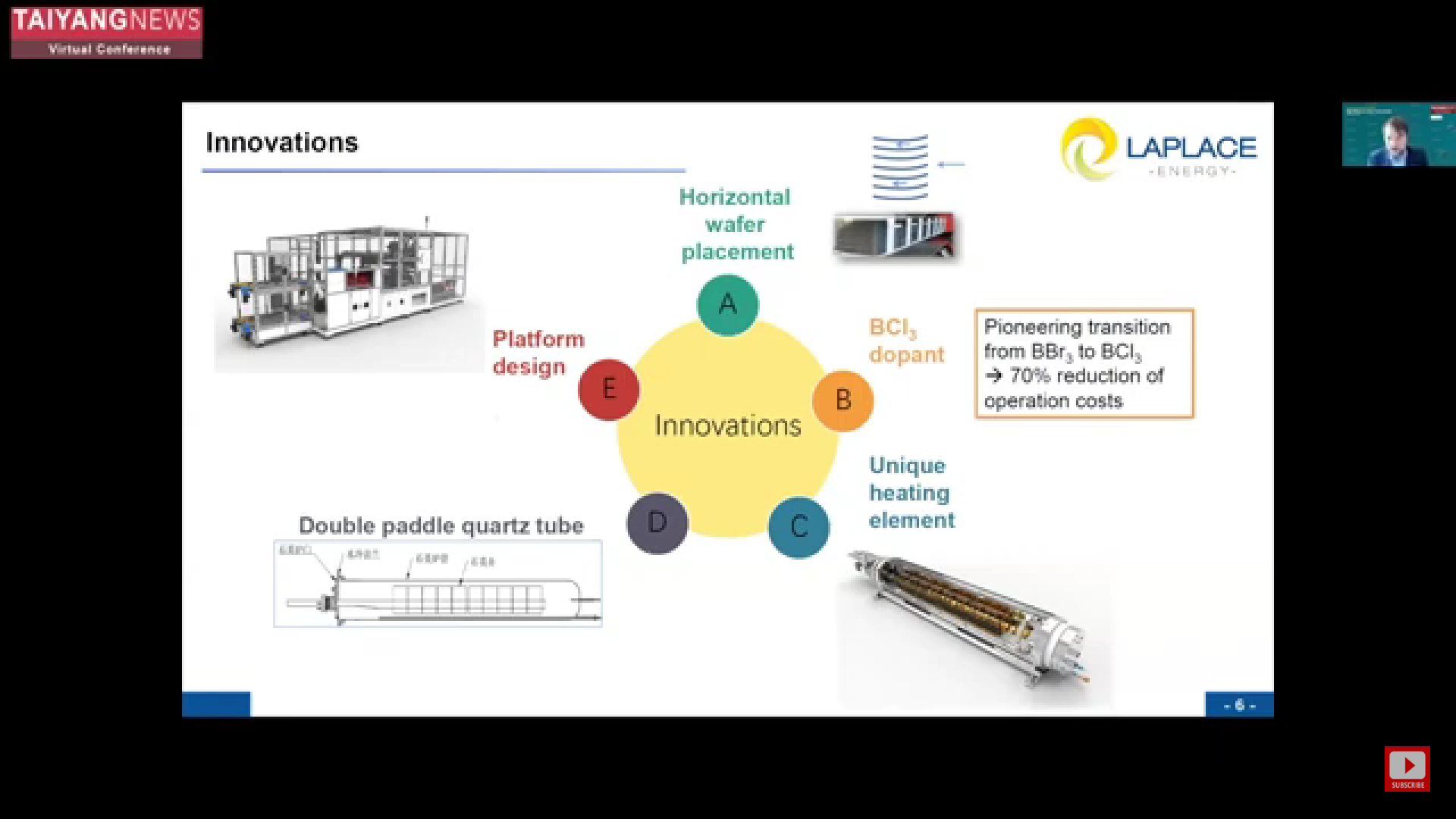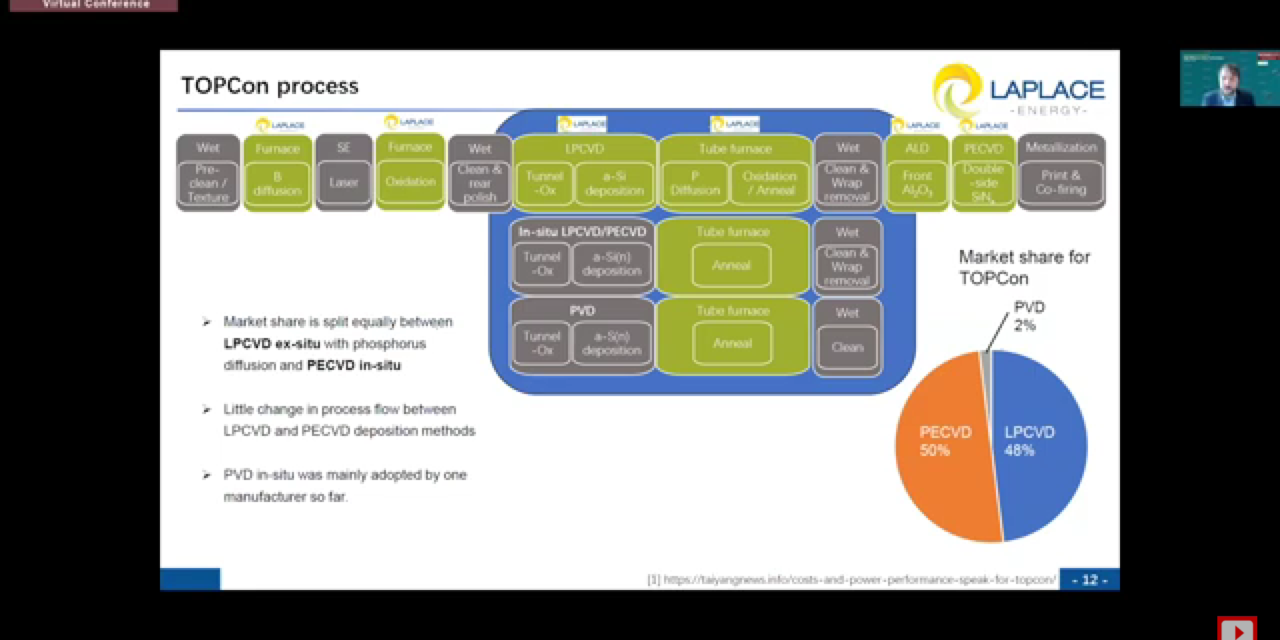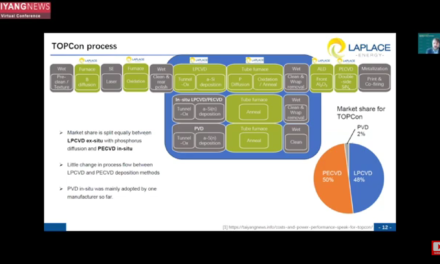- LPCVD is at par with rival technologies in terms of the number of steps involved, and provides a better–quality tunneling oxide layer, according to Laplace
- Addressing the throughput shortcoming of the typical LPCVD, Laplace is developing a platform that supports front-front loading that nearly doubles the throughput to 8,000 wafers/h
- Laplace is one of the early adopters of the BCl3 precursor and horizontal wafer processing
TOPCon, which is the talk of the solar town, is all about the rear surface engineering of an n-type base wafer, essentially applying an optimal passivation scheme. LPCVD and PECVD are the 2 main deposition technology routes employed to apply the rear passivation layers.
The former has the longest track record, as most of the early adopters of TOPCon kickstarted their mass production with LPCVD. Laplace is one of the leading equipment makers that has been an earnest believer in this technology. In addition, Laplace has also been offering relevant thermal processing tools for cell processing. At the TaiyangNews annual flagship event High-Efficiency Solar Technologies 2023 – Today, Tomorrow And Beyond, Josua Stückelburger, Laplace’s R&D Manager Europe, presented the key features and benefits of its production equipment solutions for TOPCon cell processing.
The company’s product range includes batch-type thermal diffusion tools, LPCVD deposition tools, and automation solutions for a turnkey cell line. It shipped 200 GW of TOPCon cell processing equipment to China and 18 GW to markets like Vietnam and Malaysia. Since most of today’s TOPCon pioneers started with LPCVD, a majority of the record efficiency levels at the R&D level were attained with this technology. Stückelburger said that 15 record–level performances were achieved using Laplace’s tools, including the 26.89%, most likely referring to JinkoSolar’s record in October 2023.
Benefits of LPCVD
Stückelberger presented the key competitive advantages of LPCVD over its key rival PECVD, both of which more or less have an equal market share. He also extended the comparison to PVD wherever applicable, as only one TOPCon manufacturer is using the technology in commercial production. The difference between PECVD and LPCVD starts with the application of tunneling oxide. In LPCVD, the tunneling silicon oxide layer is grown in-situ thermally, while the film is deposited in PECVD using oxygen or N2O plasma. It is well known that thermally grown silicon oxide layers are superior in quality over the deposition layers, according to Stückelberger.
For polysilicon deposition and the subsequent doping, the deposited layers in LPCVD are in an intrinsic state and then the dopant is typically induced externally followed by annealing. The PECVD method, on the other hand, enables in-situ doping of the amorphous silicon, which still needs to be activated in the annealing step, meaning the thermal activation step is required for both approaches. Emphasizing the advantage of LPCVD, Stückelberger says that this method enables better control on the polysilicon deposition to the grain level and also dopant concentration.
Addressing the common concern of the wraparound associated with LPCVD, Stückelberger says that while PECVD has relatively less wraparound, it still needs a post-process wet-chemical treatment. And while the PVD route can get rid of the wraparound, it still needs a wet-chemical cleaning step after the deposition. Thua, a wet-chemical treatment post-deposition is inevitable, irrespective of the chosen deposition method. He further stressed that the uniformity and control of the wraparound attained with LPCVD is more important than the lower amount of wraparound typically associated with PECVD.
Laplace currently offers LPCVD tools that support a deposition rate of up to 8 nm/minute, realizing a maximum throughput of 4,300 wafers/h in a single wafer loading pattern. However, PECVD tools are known to support higher throughput levels, at least for now. In order to improve the throughput of its tools, Laplace has developed an LPCVD that can support 2 wafers per slot, which nearly doubles the throughput to 8,000 wafers/h. The new tool platform is currently in the testing phase, slated for commercialization in Q3 2024. Stückelberger estimates that this back-to-back loading configuration, when it becomes available, has the potential to reduce the cost of ownership (CoO) of LPCVD by about 50%, which makes it much more cost–competitive to PECVD.
The low lifetime of quartz–ware is yet another important aspect of LPCVD costs, especially on the OpEx front. However, with the help of specific recipes and special knowhow, Laplace is able to improve the life span of the quartz boats to 6 months, and 12 months for quartz tubes instead of 4 months in the past. Laplace has shipped 650 LPCVD tools so far, representing 50% of the share, according to Stückelberger. Factoring in these recent developments and intrinsic benefits of LPCVD, Stückelberger underscores that the LPCVD is still an attractive choice for deposition technology for TOPCon. However, Laplace has also started looking beyond TOPCon; for example, the back contact cell architectures, typically referred to as XBC in China. The application of LPCVD, essentially for a cell’s back contact structures based on TOPCon (TBC), is the same – depositing stable and reproducible layers of thermal oxide and polysilicon.
Horizontal thermal processing
The key products of Laplace’s thermal processing tools are diffusion furnaces for boron and phosphorus. The diffusion furnaces of the company are based on a somewhat horizontal wafer processing, which according to the company improves process uniformity and the utilization rate of the machine’s capacity over the standard vertical wafer orientation. The concept also avoids sticking of wafer in the 2-wafers–per–slot configuration and also reduces process breakages. All this collectively helps reduce the OpEx by about 20%, claims Stückelberger. The company also offers a soft-landing system for wafer loading and unloading, which supports larger and thinner wafer handling. The system helps in increasing the mechanical yield by 1% and lowering costs by around 20% in mass production.
Coming to the crux of diffusion for TOPCon, Laplace has been a pioneer in replacing BBr3 with BCl3 as the precursor gas. The adoption of BCl3 primarily enhances homogeneity and reproducibility in large batches. An important operational benefit of using BCl3 as a precursor is that it reduces the formation of B2O3, thereby reducing the corresponding maintenance costs of quartz tubes of the furnace. Laplace claims that this reduces OpEx for the boron diffusion process by 70%. The company has shipped over 450 boron diffusion tools and 350 phosphorous tools.

Lay flat: Adopting horizontal wafer placement and employing a BCl3 boron precursor are the key differentiators for thermal processing tools from Laplace. (Source: TaiyangNews)
As a future development, Laplace is working on an innovative double paddle design quartz tube, which completely avoids direct contact between the tubes and the boat. This design can further improve quartz tube space utilization and homogeneity of the deposition due to better control of the gas flow within the system.















